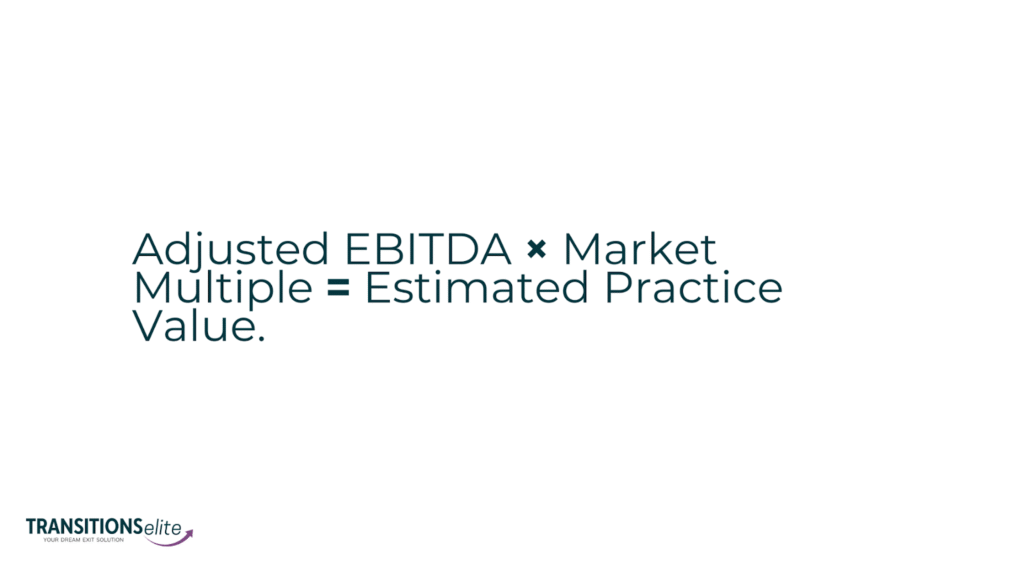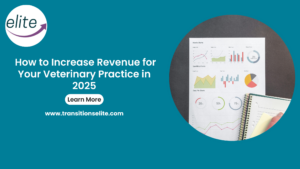How to Appraise a Veterinary Clinic and Understand Its True Value
Sentimental value only plays a minimal role for a buyer. Before you enter the market and try to sell your veterinary clinic, you need a real, accurate valuation. Owners often find themselves at the extremes of a spectrum, either underestimating or overestimating the value of their practice.
In this guide, we’ll break down what actually goes into a veterinary practice appraisal. This is a very important step, no matter if you’re planning a sale or partnership, or are simply curious about your position in the market.
Why Appraising Your Veterinary Clinic Matters
If you’re thinking about selling your veterinary clinic, knowing its real market value is, naturally, the only objective way to gauge how much you can expect for it. To put it in another way, it’s about understanding the real market value of what you’ve built so that you can make smart, confident decisions about it and your future.
It gives you a reality check, good or bad. Many owners either overestimate or underestimate what their practice is worth. A proper appraisal, based on EBITDA, staffing structure, revenue trends, and market conditions (more on that later), gives you a true baseline.
Without a valuation, you’re operating blind, which is a risk most practice owners can’t afford. Here are some reasons why a proper appraisal matters:
- You avoid leaving money on the table during a sale or transition.
- You get a clearer picture of your financial health.
- It helps with planning for retirement, succession, or tax strategy, as well as supports internal sales, loans, divorce, and estate planning.
- You gain leverage in negotiations with buyers, banks, or partners.
- You protect your legacy by making informed decisions, not emotional ones.
What Really Determines the Value of Your Practice
Veterinary practice isn’t solely about the revenue it reels in, but its potential. A buyer takes into account the future profit that it can reliably generate from the practice. It’s about how predictable, transferable, and profitable that revenue is.
Some of the biggest factors include:
- EBITDA (Earnings Before Interest, Taxes, Depreciation, and Amortization)
EBITDA is the core driver of veterinary practice appraisal. Buyers always use EBITDA to assess the profitability and use a multiple to determine your practice’s sale price. The stronger the EBITDA, the higher the value of your practice. If margins are thin or heavily reliant upon the owner, then the value gets lowered.
- Owner Dependence
If the practice’s success hinges on you being there every day, seeing every patient, doing every surgery, and making every decision, that’s a risk to any buyer. Practices with stable associate DVMs and a diversified production team are more attractive and fetch higher multiples.
- Growth Potential
Buyers tend to consider the long game more often than not. What that means is, buyers are willing to pay a premium for practices that aren’t just making profits now and have plenty of legroom for growth. Signs of growth potential include:
- Underserved local market
- Room to add another DVM
- Space to expand hours or services
- Minimal local competition
- Team Stability and Productivity
A practice without a team will not function, and that’s indisputable. A practice that has a well-trained team, has good retention, and productivity ratings always commands more value. Nothing but green flags there. Hiring is expensive and time-consuming, so buyers consider high turnover, toxic work culture, poor compensation structures, or unfilled DVM roles as a red flag.
- Location and Demographics
Location matters for every business, and vet practice is no different. Practices in high-demand, affluent, or growing regions often command higher value because they have higher foot traffic and faster growth potential. At the same time, rural practices might have lower competition but also a smaller buyer pool.
Buyers look at factors like median household income in an area, the number of local pet owners, competition, as well as future growth trends of a region.
- Clean Financials and Systems
Buyers won’t tolerate a practice with a messy financial record. They want transparency, clean books, revenue that is trackable, and an efficient system for billing, scheduling, and inventory. Without these, it gives your practice a label of untrustworthy.
- Type of Services and Equipment
Naturally, offering multiple services such as surgery, dentistry, and ultrasound increases your appeal, as it showcases that there are numerous sources of revenue. Along with that, similar to the location factor, your facility and equipment make a massive difference. Is your practice modern, clean, and fully functional? Or is it outdated and due for a huge overhaul?
Factors that impact value here:
- Digital vs. paper records (EMR is a plus)
- Diagnostic and imaging capabilities (in-house labs, ultrasound)
- Dental and surgical equipment quality
- Facility layout, aesthetics, and workflow
- Ownership or lease terms on the building
Buyers will factor in how much investment they’d need to make just to bring the clinic up to par.
Bonus: Your Practice’s Story
Not always, nor should you rely on this factor, but a good broker will always highlight the story behind your practice. Its beginnings, how it has grown under your leadership, the culture and reputation you’ve built, and more. These softer, more human and emotional aspects can help justify premium pricing at times.
How to Calculate the Worth of Your Veterinary Practice
While a professional valuation is recommended to get a more accurate veterinary practice appraisal, here’s how the value process works generally:
- Calculating EBITDA
It starts with your EBITDA. This measures your clinic’s core profitability by excluding non-operating and non-cash expenses. The formula for it is:
Revenue – Operating Expenses (excluding interest, taxes, depreciation, and amortization) = EBITDA
- Adjust for Owner Add-Backs
Next, adjust EBITDA to reflect the real earning power of your practice by adding back discretionary expenses that won’t continue under new ownership. Common add-backs include:
- Owner’s salary and bonuses
- Personal or non-clinic expenses like travel or car leases
- One-time costs like equipment or consultants
- Family members on the payroll who play no clinical role
The result is your Adjusted EBITDA, which is a more accurate measure of what a buyer can expect to earn.
- Apply a Market Multiple
Now, the value is calculated using the formula: Adjusted EBITDA × Market Multiple.
The multiple reflects how attractive your practice is to buyers and typically ranges between 4x and 8x, depending on factors like location, growth potential, number of DVMs, team and client stabilities, and the type of buyer (individual or private equity firm).
Let’s take an example to make this easier. Say your adjusted EBITDA is $400,000, and your practice earns a 6x multiple, the estimated value would be: $400,000 × 6 = $2.4 million.
- Consider Real Estate Separately
This may not always apply, but if you own the building, it’s generally valued as an independent asset and not a part of the practice. So, you can choose to sell the property as part of the deal or lease it to the buyer and retain it as a passive income asset. Real estate value is based on local market conditions and fair rental income.
- Factor in Debt or Liabilities
Most buyers purchase the assets of a business, so they do not typically assume your debts. If the debt level is manageable, it can be covered, but if it’s significant enough to influence profitability, it can negatively influence negotiations. This varies widely from case to case.
So, all in all, to calculate the worth of your vet practice, the formula is:

Common Vet Business Valuation Methods
When selling your veterinary clinic, in order to get an accurate valuation, buyers, brokers, and appraisers use several recognized methods. Here’s what they are and when they’re used:
- Income Approach (EBITDA or Capitalization of Earnings)
As you know by now, this is the most commonly used method by practice sales advisors today. It measures a practice’s ability to generate future profits. It reflects the real earning potential of the practice and is the preferred method for private equity, institutional buyers, and sophisticated investors.
- Market Approach (Comparable Sales)
In this method, a closer look at the recent sales of similar practices is taken to estimate value, as it indicates market demand and creates pricing benchmarks. This method compares your clinic to other similar-sized, similarly located practices that have recently sold, adjusting for differences.
- Asset-Based Approach (Net Asset Value)
This method is used… less commonly, but it still applies in special cases. It is used to measure the book value of tangible and intangible assets, such as equipment, inventory, leaseholds, and goodwill.
- Rule of Thumb Multiples (Revenue-Based)
Similar to the above, this method is used less commonly for being outdated and overly simplistic. However, it does provide an estimate. It measures a multiple of gross revenue by applying a standard multiple to top-line revenue without considering profitability, which is also what makes it risky.
Two practices with identical revenue can have vastly different profits and value. That is why it’s often used only for informal estimates, not final valuations.
What Boosts (or Hurts) Your Valuation
| Boosts | Hurts |
| High profitability, especially above 15–20%, significantly increases your value. Moreover, stable cash flow and clean financials are rewarded with higher valuations. | Clinics that are overly dependent on the owner. |
| Having more than one doctor reduces buyer risk and makes your practice more scalable. It shows sustainability beyond the owner’s involvement. | A high turnover or short-staffing. |
| Room to expand hours, services, or hire more staff signals future upside to buyers, along with underutilized locations with good demographics, which attract aggressive offers. | Poor or inconsistent financials (incomplete records, mix of personal and business expenses, and erratic income all erode trust to a great extent). |
| A clinic with low staff turnover, trained techs, and a collaborative culture builds buyer confidence. | Outdated systems, unmaintained and obsolete equipment. |
| A clinic in a high-income or growing area with plenty of pet owners commands stronger multiples. Urban areas are especially valuable. | Weak online/offline presence. |
| Buyers love modern “plug-and-play” setups with minimal upgrade needs. | Little to no client retention. |
Buyers are paying for profitability, predictability, and potential. Strengthen those, and your valuation will follow.
Getting Ready for the Appraisal
Now, let’s talk about how you can prepare your practice for appraisal. Before running the numbers, get the house in order. So, here’s what you do:
- Prepare all the documents you’ll need
- 3 years of tax returns and profit & loss statements
- Year-to-date financials
- Production reports by DVM (including the owner)
- Staff payroll summary and benefits breakdown
- Lease agreement or property deed
- Equipment and inventory list
- Client metrics (such as active clients, average invoice)
- Contracts, loans, and liabilities
Red Flags to Fix Before the Appraisal
In order to get the best valuation possible, you must eliminate all the factors that might result in deductions. So, separate personal and business expenses. Then, make sure your clinic can run independently, staff retention and customer retention rates are high, broken and old equipment is fixed and updated, and all employment agreements are clear. No paper should be vague.
Preparing Your Team
You must also prepare your team. Generally, it’s best to maintain confidentiality for most employees aside from those in key roles, whose assistance might be needed. Provide a documented SOP that shows the business can run without you, and cross-train staff and tighten up workflows if need be.
Working With a Professional Appraiser
If you’re unsure about the entire process, considering there are so many nuances to a proper valuation, it’s recommended to seek professional assistance. A veterinary-specific appraiser understands said nuances like adjusted EBITDA calculations and buyer risk assessments.
A DIY estimate or online calculator may mislead you. Instead, working with a pro gives you:
- A thorough review of financial and operational performance
- Adjustments for one-time or discretionary expenses
- A full written report with methodology and valuation range
- Strategic recommendations, if paired with a broker
Next Steps After the Appraisal
Once you’ve got your appraisal, a couple of things are set into motion. First, you begin your exit strategy by defining your ideal timeline. It can be anywhere from 6 months to 3 years, as it varies from one clinic to another. Next, you decide whether you want a full exit or would like to stay on part-time. The earlier a professional vet practice sales advisor like Transitions Elite is involved, the sooner your terms can be optimized.
Improve Your Value Before Listing
Before your listing goes live, to get the highest value for it, do the following:
- Hire or stabilize associate DVMs
- Boost margins by improving efficiency
- Modernize outdated tech or equipment
- Strengthen client retention and online visibility
Legal & Financial Prep
Legal and financial matters can get complicated, so meet with a CPA to plan for taxes on sale proceedings and review your corporate structure and contracts with an attorney.
Need Expert Help? Let Transitions Elite Handle It

When it comes to selling your vet practice, the appraisal aspect is just the beginning. You need an advisor who understands the nuances of your profession, the current market, and even connects with the human side of things, not just another listing service.
At Transitions Elite, we specialize in helping veterinary and optometry practice owners evaluate, transition, and sell their practices. We know each case is unique, so we don’t offer cookie-cutter appraisals. We dive deep into your business and your goals, and build a custom roadmap that gets you there.
Here’s how our veterinary practice sales services stand out:
- We bring in proven formulas that reflect real-world buyer behavior in your industry. We go far beyond industry averages or revenue multipliers.
- We provide you with objective reasons if your practice isn’t ready for sale, all while giving pointers that will help put you in an advantageous position for the sale.
- We build a custom exit strategy for you based on your goals and aspirations.
- From appraisal to closing, we guide you through negotiations, legal, tax, and everything in between.
- We create a controlled bidding environment by confidentially marketing to a network of vetted, high-quality buyers to make sure you never settle for just one offer.
Most brokers treat a DVM and an OD like they’re the same thing. We don’t. We know how to position your practice for the right buyer, at the right time, with the right terms. It’s the same playbook we’ve used to help dozens of owners walk away with life-changing deals.
Partnering with us, you get direct access to Tom Civitano’s expertise, one of the industry’s most respected dealmakers, who has personally led hundreds of millions in successful sales.
Get a free evaluation of your practice today and find out what your clinic is really worth.
Closing Thoughts
A veterinary practice is built upon hard work and soul, so numbers alone won’t do it justice. It’s about securing a legacy. With the right guidance, you don’t have to guess your way through it. Get the facts, fix what needs fixing, and take control of your future with the right experts by your side.
FAQs
How Often Should You Get a Veterinary Practice Appraisal?
Even if you’re not planning to sell soon, getting an appraisal every 2–3 years keeps you informed about your clinic’s financial health. Regular valuations help identify areas for improvement, prepare for expansion, and make sure you’re not caught off guard if an unexpected sale opportunity or partnership arises.
How do I Value my Veterinary Practice?
Several factors must be taken into account to measure the value of a vet practice, such as profitability, client loyalty, staff, location, quality of facility, online and offline reputation, types of services offered, and how dependent the business is on you. To get a truly accurate number, it’s best to work with a professional appraiser who specializes in veterinary practices.
Is 5% a Good EBITDA?
A 5% EBITDA margin is on the lower end for a veterinary practice. While it’s not terrible, most buyers prefer to see margins of 10%-20% or higher, depending on the size, location, and type of clinic.

Melani Seymour, co-founder of Transitions Elite, helps veterinary practice owners take action now to maximize value and secure their future.
With over 15 years of experience guiding thousands of owners, she knows exactly what it takes to achieve the best outcome.
Ready to see what your practice is worth?











